软件需求规格说明书(Software Requirement Specification)模板
srs安全要求规格缩写
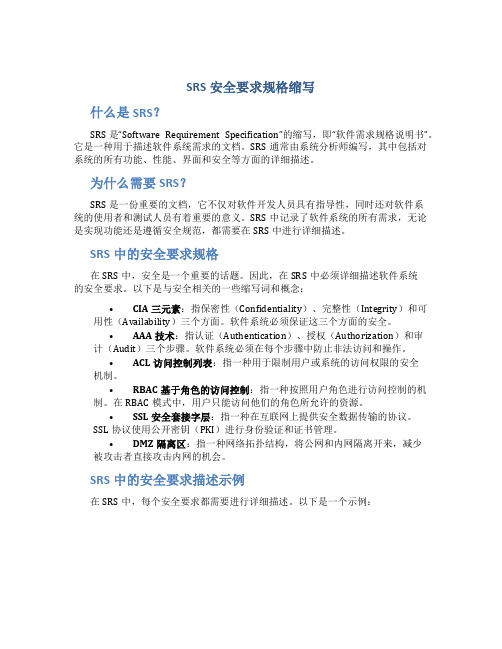
SRS安全要求规格缩写什么是SRS?SRS是“Software Requirement Specification”的缩写,即“软件需求规格说明书”。
它是一种用于描述软件系统需求的文档。
SRS通常由系统分析师编写,其中包括对系统的所有功能、性能、界面和安全等方面的详细描述。
为什么需要SRS?SRS是一份重要的文档,它不仅对软件开发人员具有指导性,同时还对软件系统的使用者和测试人员有着重要的意义。
SRS中记录了软件系统的所有需求,无论是实现功能还是遵循安全规范,都需要在SRS中进行详细描述。
SRS中的安全要求规格在SRS中,安全是一个重要的话题。
因此,在SRS中必须详细描述软件系统的安全要求。
以下是与安全相关的一些缩写词和概念:•CIA三元素:指保密性(Confidentiality)、完整性(Integrity)和可用性(Availability)三个方面。
软件系统必须保证这三个方面的安全。
•AAA技术:指认证(Authentication)、授权(Authorization)和审计(Audit)三个步骤。
软件系统必须在每个步骤中防止非法访问和操作。
•ACL访问控制列表:指一种用于限制用户或系统的访问权限的安全机制。
•RBAC基于角色的访问控制:指一种按照用户角色进行访问控制的机制。
在RBAC模式中,用户只能访问他们的角色所允许的资源。
•SSL安全套接字层:指一种在互联网上提供安全数据传输的协议。
SSL协议使用公开密钥(PKI)进行身份验证和证书管理。
•DMZ隔离区:指一种网络拓扑结构,将公网和内网隔离开来,减少被攻击者直接攻击内网的机会。
SRS中的安全要求描述示例在SRS中,每个安全要求都需要进行详细描述。
以下是一个示例:3.2 数据安全3.2.1 数据加密系统在传输敏感信息时,应采用SSL协议进行加密传输。
公开密钥证书由可信的第三方机构颁发,使用时需进行身份验证和证书管理。
对于用户提交的元数据和敏感数据,应使用AES 256位密码算法进行加密。
软件需求规格说明书完整版
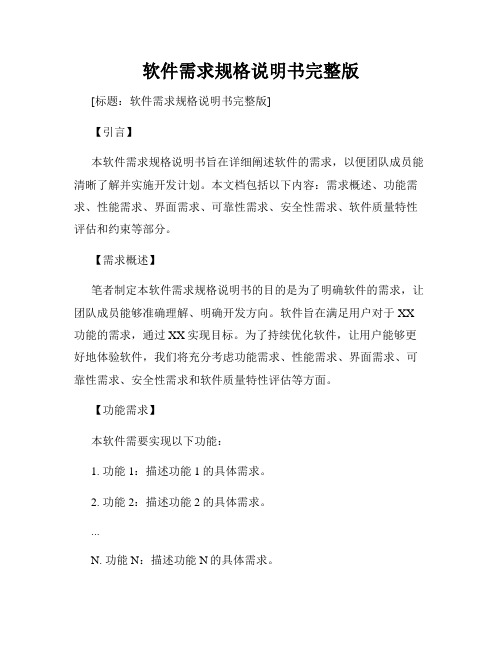
软件需求规格说明书完整版[标题:软件需求规格说明书完整版]【引言】本软件需求规格说明书旨在详细阐述软件的需求,以便团队成员能清晰了解并实施开发计划。
本文档包括以下内容:需求概述、功能需求、性能需求、界面需求、可靠性需求、安全性需求、软件质量特性评估和约束等部分。
【需求概述】笔者制定本软件需求规格说明书的目的是为了明确软件的需求,让团队成员能够准确理解、明确开发方向。
软件旨在满足用户对于XX 功能的需求,通过XX实现目标。
为了持续优化软件,让用户能够更好地体验软件,我们将充分考虑功能需求、性能需求、界面需求、可靠性需求、安全性需求和软件质量特性评估等方面。
【功能需求】本软件需要实现以下功能:1. 功能1:描述功能1的具体需求。
2. 功能2:描述功能2的具体需求。
...N. 功能N:描述功能N的具体需求。
为了保证软件的流畅运行,我们需要考虑以下性能需求:1. 性能1:描述性能1的需求,如响应时间、处理速度等。
2. 性能2:描述性能2的需求,如并发性能、负载能力等。
...N. 性能N:描述性能N的需求。
【界面需求】软件的界面需求应满足以下要求:1. 界面1:描述界面1的需求,如界面布局、元素排列等。
2. 界面2:描述界面2的需求,如颜色搭配、字体样式等。
...N. 界面N:描述界面N的需求。
【可靠性需求】为了确保软件的可靠性,我们需要考虑以下方面:1. 可靠性1:描述可靠性1的需求,如错误处理、数据完整性等。
2. 可靠性2:描述可靠性2的需求,如灾备恢复、故障处理等。
...N. 可靠性N:描述可靠性N的需求。
为了保护用户数据和软件安全,我们需要考虑以下安全性需求:1. 安全性1:描述安全性1的需求,如访问控制、数据加密等。
2. 安全性2:描述安全性2的需求,如用户认证、防止攻击等。
...N. 安全性N:描述安全性N的需求。
【软件质量特性评估】为了保证软件质量,我们将评估以下特性:1. 质量特性1:描述质量特性1的评估方法和要求,如可维护性、易扩展性等。
软件需求规格说明书(Software Requirement Specification)模板
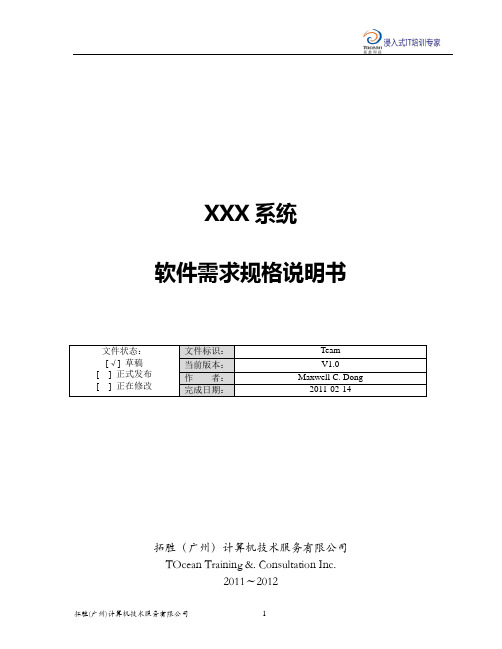
XXX系统软件需求规格说明书文件状态:[√] 草稿[ ] 正式发布[ ] 正在修改文件标识:Team当前版本:V1.0作者:Maxwell C. Dong完成日期:2011-02-14 拓胜(广州)计算机技术服务有限公司TOcean Training &. Consultation Inc.2011~2012版本编号说明:如形成文件、变更内容和变更范围变更日期变更人批准日期批准人目录XXX系统 (1)软件需求规格说明书 (1)目录 (3)1.软件产品描述 (4)1.文档编写目的 (4)2.产品名称 (4)3.产品背景 (4)4.名词解释 (4)2.产品需求概述 (5)1.功能简介 (5)2.运行环境 (5)3.条件与限制(可选) (5)3.功能用例描述 (6)1.产品参与者 (6)2.功能需求 (6)3.功能需求列表 (6)4.详细功能需求 (7)1.功能1 (7)5.非功能性需求 (8)1.性能 (8)2.安全 (8)3.备份与恢复 (8)4.移植 (8)5.健壮性 (8)6.重用 (8)7.维护 (8)8.软件质量需求 (8)6.附录 (9)1.附录一——术语表 (9)2.附录二——参考引用 (9)1.软件产品描述1.文档编写目的【说明编写本软件需求规格说明书的目的,指出预期的读者。
】2.产品名称【本项目的名称,包括项目的全名、简称、代号、版本号。
】3.产品背景【本项目的背景,包括项目产品委托单位、开发单位和主管部门、该产品系统和其他系统的关系】4.名词解释【参见附录一(术语表)。
】2.产品需求概述1.功能简介【对产品的基本功能做一个简介,包括:1.本产品的开发意图、应用目标及作用范围。
2.概略介绍了产品所具有的主要功能。
可以用列表的方法给出,也可以用图形表示主要的需求分组以及它们之间的联系,例如数据流程图的顶层图或类图等。
3.说明本产品与其他相关产品的关系,是独立产品还是一个较大产品的组成部分。
srs技术文档说明
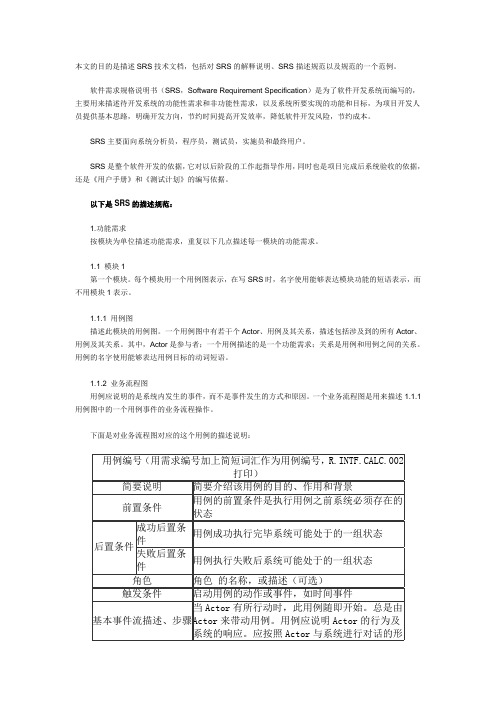
本文的目的是描述SRS技术文档,包括对SRS的解释说明、SRS描述规范以及规范的一个范例。
软件需求规格说明书(SRS,Software Requirement Specification)是为了软件开发系统而编写的,主要用来描述待开发系统的功能性需求和非功能性需求,以及系统所要实现的功能和目标,为项目开发人员提供基本思路,明确开发方向,节约时间提高开发效率,降低软件开发风险,节约成本。
SRS主要面向系统分析员,程序员,测试员,实施员和最终用户。
SRS是整个软件开发的依据,它对以后阶段的工作起指导作用,同时也是项目完成后系统验收的依据,还是《用户手册》和《测试计划》的编写依据。
以下是SRS的描述规范:1.功能需求按模块为单位描述功能需求,重复以下几点描述每一模块的功能需求。
1.1 模块1第一个模块。
每个模块用一个用例图表示,在写SRS时,名字使用能够表达模块功能的短语表示,而不用模块1表示。
1.1.1 用例图描述此模块的用例图。
一个用例图中有若干个Actor、用例及其关系,描述包括涉及到的所有Actor、用例及其关系。
其中,Actor是参与者;一个用例描述的是一个功能需求;关系是用例和用例之间的关系。
用例的名字使用能够表达用例目标的动词短语。
1.1.2 业务流程图用例应说明的是系统内发生的事件,而不是事件发生的方式和原因。
一个业务流程图是用来描述1.1.1用例图中的一个用例事件的业务流程操作。
下面是对业务流程图对应的这个用例的描述说明:以下是SRS描述规范的一个范例:1.功能需求1.1业务区管理1.1.1 用例图1.1.2 业务流程图业务区创建范例说明:以上范例是直放站统一通讯管理系统的SRS中的第三章节,是用来描述系统的功能需求的,其中,1.1小节描述了其中一个模块——业务区管理的功能需求。
其中包括了业务区管理这一模块的用例图,以及对这一用例图中由Actor带动的三个用例:业务区创建、业务区管理、业务区删除的业务流程图描述,列出了其中一个用例——业务区创建的业务流程图,以及对这个用例的简要说明、前置条件、后置条件、角色、触发条件、基本事件流、备选事件流、特殊需求等的描述。
软件需求规格说明书

软件需求规格说明书用户需求确认书列举的需求已包含现阶段所用需求,需求明确,符合要求用户职务用户签名签订日期目录1.引言1.1编写目的 (4)1.2范围 (4)1.3参考资料 (4)2.项目概述2.1产品描述 (4)2.2产品功能 (5)2.3运行环境 (5)2.4假设和依据 (6)3.具体需求3.1系统角色 (6)3.2登录界面 (8)3.3学生管理系统 (8)3.3.1导入学生信息 (9)3.3.2选课系统 (9)3.3.3查看课程介绍/查看发表评论 (10)3.3.4查看个人成绩 (11)3.3.5查看科目补考成绩 (11)3.4教师管理系统 (11)3.4.1导入教师信息 (12)3.4.2查看负责课程 (12)3.5管理员系统 (13)3.5.1导入学生选课目录 (15)3.5.2导出课程成绩 (15)3.5.3修改补考时间 (15)3.5.1修改课程负责人 (16)3.5.2查看课程选修状况 (16)3.6系统维护 (16)3.6.1数据字典的维护 (16)4.非功能需求4.1性能需求 (16)4.2安全性需求 (17)4.3可用性需求 (17)4.4用户文档 (17)4.5其他需求 (17)5.外部接口需求5.1用户接口 (18)5.2硬件接口 (18)5.3软件接口 (18)5.4通信接口 (18)1.引言1.1编写目的为了是用户更清楚的了解到开发此软件的性能需求以及作用功能,清晰地描述出此软件在开发过程中所需的资料技术等等1.2范围说明:a.学生管理系统,webAPPb.该软件可以解决在某些教务处使用高峰期,学生开学选课阶段,经常会出现运行迟缓,系统崩溃等问题c.解决学生选课时对课程的认知度不充分性,拥有对课程的详细介绍及上级学生对该课程的评论及认识d.老师可以录入课程成绩,自动计算该学期该课程平均成绩、及格率等等,学生也可以更清楚了解课程的具体要求.1.3参考资料参考相关软件设计规划书,以及相关开发文献2项目概述2.1产品概述就用了两年多的福州大学教务处的而言,功能繁多,基本上所有学生、教师等关于信息、课程、学习、报名乃至于课表作息等功能都一应俱全,也正因为此,在某些教务处使用高峰期,如学生开学选课阶段,经常会出现运行迟缓,系统崩溃等问题,在情况紧急之下甚至会导致某些严重后果。
软件需求规格说明书(RUP版)

软件需求规格说明书1. 文档概述 (1)1.1目的 (1)1.2范围 (1)1.3 定义、首字母缩写词和缩略语 (1)1.4参考资料 (2)1.5 概述 (2)2. 整体说明 (2)2.1用例模型 (2)2.2 假设与依赖关系 (2)3. 具体需求 (2)3.1用例描述 (2)3.2补充需求 (3)4.支持信息 (3)1. 文档概述[该部分主要是对软件需求规格说明书文档进行基本的描述,包括该文档的目的、范围、术语定义、参考资料以及概要。
][软件需求规格说明书用来系统、完整地记录系统的软件需求。
该软件需求说明书的基础是用例分析技术。
因此该文档中应包括用例模型、补充规约等内容。
]1.1目的[在此小节中,主要对软件需求规格说明书的目的做一概要性说明,通常软件需求规格说明书应详细地说明应用程序、子系统的外部行为,还要说明非功能性需求、设计约束,以及其它的相关因素。
]1.2范围[系统是有范围的,而不是无限扩展的,对于无限扩展的需求是无法进行描述的。
因此,在本小节应该对该说明书所涉及的项目范围进行清晰的界定。
指定该规格说明书适用的软件应用程序、特性或者其它子系统分组、其相关的用例模型。
当然在此也需要列出会受到该文档影响的其它文档。
]1.3 定义、首字母缩写词和缩略语[与其它文档一样,该文档也需要将本文档中所涉及的所有术语、缩略语进行详细的定义。
还有一种可简明的做法,就是维护在一个项目词汇表中,这样就可以避免在每个文档中都重复很多内容。
]1.4参考资料[在这一小节中,应完整地列出该文档引用的所有文档。
对于每个引用的文档都应该给出标题、标识号、日期以及来源,为阅读者查找这些文档提供足够详细的信息。
]1.5 概述[在本小节中,主要是说明软件需求规格说明书各个部分所包含的主要内容,就像一个文章摘要一样。
同时也应该对文档的组织方式进行解释。
]2. 整体说明[在本节中,将对整个软件需求进行总体性的描述,以期让读者对整个软件系统的需求有一个框架性的认识。
软件需求规格说明书模板

****项目需求规格说明书编制:日期:审核:日期:批准:日期:XXXX公司文档修订记录目录1. 引言 (1)1.1文档目的 (1)1.2参考资料 (1)1.3术语定义 (1)2. 项目背景 (1)3. 需求概述 (1)3.1系统总体功能 (1)3.2业务流程概述 (2)3.3系统用户分析 (2)3.3.1 用户角色 (2)3.3.2 用户范围 (2)4. 系统功能性需求 (2)4.1合同管理 (2)4.1.1 制定回款计划 (2)4.1.2 管理合同基本信息 (3)4.2XX模块 (4)4.2.1 用例3 (4)4.2.2 用例4 (4)5. 其他项目需求 (4)5.1系统接口 (4)5.1.1 内部接口 (4)5.1.2 外部接口 (5)5.2应用环境 (5)5.2.1 网络拓扑 (5)5.2.2 硬件环境 (5)5.2.3 软件环境 (5)5.3系统性能 (5)5.3.1 性能指标 (5)5.3.2 稳定性指标 (5)5.3.3 可扩展性 (5)5.3.4 可移植性 (5)5.3.5 故障处理 (6)5.4系统安全性 (6)6. 需求变化跟踪表 (6)7. 客户确认签字 (6)1.引言1.1文档目的[阐明文档编写的目的,指明读者对象。
]本文档阐述了项目的建设目标、建设思路、总体框架、总体需求及各子系统需求,将作为系统开发的重要参考和项目验收的主要依据。
本文档的预期读者包括甲方项目组相关人员、乙方项目组成员(包括项目经理、程序员、市场相关人员等)、监理方相关人员,以及其他与本项目建设相关的人员。
1.2参考资料【应按文档号和标题列出本文档引用的所有文档。
】【可列举与本项目相关的政策法规;如:】《中华人民共和国环境保护法》1.3术语定义项目简称定义;系统简称定义;用户简称定义:其他业务术语定义;2.项目背景[简要介绍本项目如下方面的内容:建设背景、建设目的、建设思路]3.需求概述3.1系统总体功能以图形结合文字说明的方式描述:本项目的各个子系统以及每个子系统的主要功能模块。
软件需求规格说明模板(国际版)

Software RequirementsSpecificationfor<Project>软件需求规格说明Version 1.0 approvedPrepared by <author><organization><date created>Translated by Hiphonejohn Contact Me , E-mail:hiphonejohn@Table of Contents目录Table of Contents目录 (iii)Revision History版本历史 (iii)1.Introduction 引言 (1)1.1Purpose 目的 (1)1.2Document Conventions 文档约定 (1)1.3Intended Audience and Reading Suggestions使用人群和阅读建议 (1)1.4Product Scope 产品范围 (1)1.5References参考文献 (1)2.Overall Description 总体描述 (2)2.1Product Perspective产品愿景 (2)2.2Product Functions产品功能 (2)2.3User Classes and Characteristics用户类型和特征 (2)2.4Operating Environment操作环境 (3)2.5Design and Implementation Constraints设计和实现约束 (3)2.6User Documentation用户文档 (3)2.7Assumptions and Dependencies假设和依赖 (3)3.External Interface Requirements外部接口需求 (4)3.1User Interfaces用户接口 (4)3.2Hardware Interfaces硬件接口 (4)3.3Software Interfaces软件接口 (4)3.4Communications Interfaces通信接口 (4)4.System Features系统特征 (5)4.1System Feature 1系统特征1 (5)4.2System Feature 2 (and so on)系统特征2,如上。
软件需求规格说明书
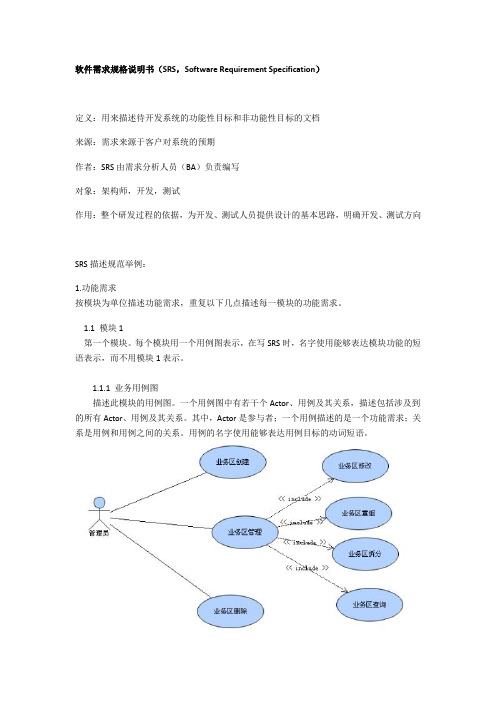
软件需求规格说明书(SRS,Software Requirement Specification)
定义:用来描述待开发系统的功能性目标和非功能性目标的文档
来源:需求来源于客户对系统的预期
作者:SRS由需求分析人员(BA)负责编写
对象:架构师,开发,测试
作用:整个研发过程的依据,为开发、测试人员提供设计的基本思路,明确开发、测试方向
SRS描述规范举例:
1.功能需求
按模块为单位描述功能需求,重复以下几点描述每一模块的功能需求。
1.1 模块1
第一个模块。
每个模块用一个用例图表示,在写SRS时,名字使用能够表达模块功能的短语表示,而不用模块1表示。
1.1.1 业务用例图
描述此模块的用例图。
一个用例图中有若干个Actor、用例及其关系,描述包括涉及到的所有Actor、用例及其关系。
其中,Actor是参与者;一个用例描述的是一个功能需求;关系是用例和用例之间的关系。
用例的名字使用能够表达用例目标的动词短语。
1.1.2 业务流程图
用例应说明的是系统内发生的事件,而不是事件发生的方式和原因。
一个业务流程图是用来描述1.1.1用例图中的一个用例事件的业务流程操作。
1.1.3 用例描述
下面是对业务流程图对应的这个用例的描述说明:
用例举例。
软件需求规格说明书
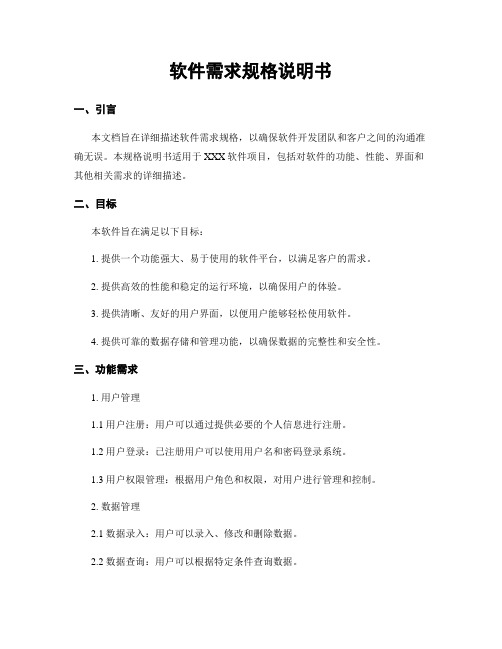
软件需求规格说明书一、引言本文档旨在详细描述软件需求规格,以确保软件开发团队和客户之间的沟通准确无误。
本规格说明书适用于XXX软件项目,包括对软件的功能、性能、界面和其他相关需求的详细描述。
二、目标本软件旨在满足以下目标:1. 提供一个功能强大、易于使用的软件平台,以满足客户的需求。
2. 提供高效的性能和稳定的运行环境,以确保用户的体验。
3. 提供清晰、友好的用户界面,以便用户能够轻松使用软件。
4. 提供可靠的数据存储和管理功能,以确保数据的完整性和安全性。
三、功能需求1. 用户管理1.1 用户注册:用户可以通过提供必要的个人信息进行注册。
1.2 用户登录:已注册用户可以使用用户名和密码登录系统。
1.3 用户权限管理:根据用户角色和权限,对用户进行管理和控制。
2. 数据管理2.1 数据录入:用户可以录入、修改和删除数据。
2.2 数据查询:用户可以根据特定条件查询数据。
2.3 数据导出:用户可以将数据导出为Excel或其他格式的文件。
3. 报表生成3.1 报表定义:用户可以定义报表的格式和内容。
3.2 报表生成:根据用户定义的报表格式和内容,生成相应的报表。
4. 通知和提醒4.1 通知管理:系统可以向用户发送通知和提醒。
4.2 提醒设置:用户可以设置提醒的方式和频率。
5. 系统设置5.1 用户管理:管理员可以管理用户信息和权限。
5.2 界面设置:用户可以自定义界面的样式和布局。
5.3 系统维护:管理员可以进行系统备份、恢复和升级。
四、性能需求1. 响应时间:系统应在用户进行操作后的2秒内给出响应。
2. 并发性能:系统应支持1000个并发用户的正常操作。
3. 数据处理能力:系统应能够处理每秒1000条数据的输入和输出。
五、界面需求1. 用户界面:界面应简洁、直观,符合用户使用习惯。
2. 响应式设计:界面应能够在不同的设备和屏幕尺寸上正常显示和操作。
3. 多语言支持:界面应支持多种语言切换。
六、安全需求1. 用户认证:用户登录时应进行身份验证,确保只有合法用户可以访问系统。
软件需求规格说明书
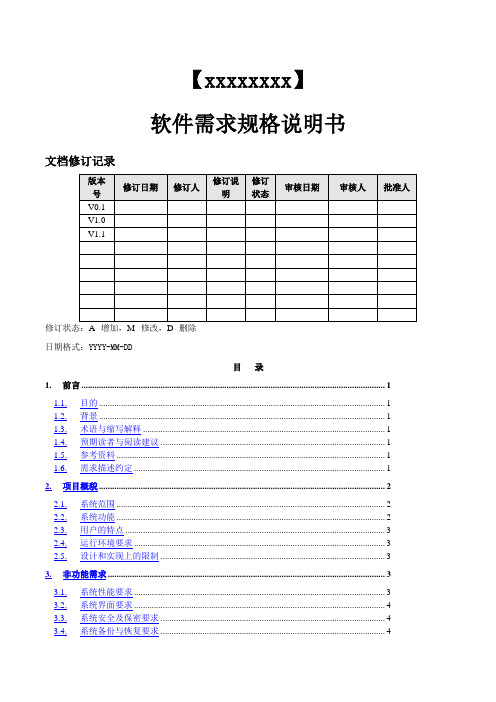
【xxxxxxxx】软件需求规格说明书文档修订记录修订状态:A--增加,M--修改,D--删除日期格式:YYYY-MM-DD目录1.前言 (1)1.1.目的 (1)1.2.背景 (1)1.3.术语与缩写解释 (1)1.4.预期读者与阅读建议 (1)1.5.参考资料 (1)1.6.需求描述约定 (1)2.项目概貌 (2)2.1.系统范围 (2)2.2.系统功能 (2)2.3.用户的特点 (3)2.4.运行环境要求 (3)2.5.设计和实现上的限制 (3)3.非功能需求 (3)3.1.系统性能要求 (3)3.2.系统界面要求 (4)3.3.系统安全及保密要求 (4)3.4.系统备份与恢复要求 (4)3.5.系统日志 (4)4.外部接口说明 (4)5.其他需求 (5)6.功能需求的详述 (5)6.1.IDC管理 (5)6.2.BAS地址池下发 (5)6.3.BAS运行状态监控 (5)6.3.1需求详细描述 (5)6.3.2内部接口 (6)6.4.BAS应急预案 (6)6.4.1需求详细描述 (6)6.4.2内部接口 (7)6.5.配置下发优化 (7)6.5.1需求详细描述 (7)6.5.2内部接口 (7)6.6.机历卡优化 (7)6.6.1需求详细描述 (7)6.6.2内部接口 (8)6.7.告警转发改进 (8)6.7.1需求详细描述 (8)6.7.2内部接口 (8)6.8.设备一键诊断 (8)6.8.1需求详细描述 (8)6.8.2内部接口 (9)6.9.开通工单告警 (9)6.9.1需求详细描述 (9)6.9.2内部接口 (9)6.10.工程信息导入 (9)6.10.1需求详细描述 (9)6.10.2内部接口 (9)6.11.巡检资源组管理 (9)6.11.1需求详细描述 (9)6.11.2内部接口 (10)6.12.巡检配置 (10)6.12.1需求详细描述 (10)6.12.2内部接口 (10)6.13.网络流量优化报表 (10)6.13.1需求详细描述 (10)6.13.2内部接口 (10)6.14.故障统计优化 (10)6.14.1需求详细描述 (10)6.14.2内部接口 (11)7.附件:BAS监控指标采集办法 (11)7.1.设备上行口运行情况监控 (11)7.2.检查BGP状态 (12)7.3.检查RADIUS状态 (13)7.4.和上一周期对比用户数 (15)7.5.IP地址池利用率情况检查 (16)1. 前言1.1. 目的通过本文档定义的需求,以求在项目组员与相关干系人之间达成一致的需求描述。
软件需求规格说明
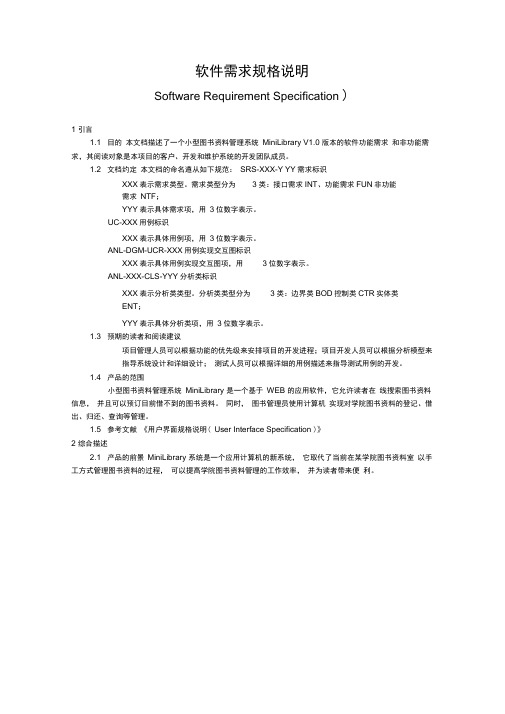
软件需求规格说明Software Requirement Specification )1 引言1.1 目的本文档描述了一个小型图书资料管理系统MiniLibrary V1.0 版本的软件功能需求和非功能需求,其阅读对象是本项目的客户、开发和维护系统的开发团队成员。
1.2 文档约定本文档的命名遵从如下规范:SRS-XXX-Y YY需求标识XXX表示需求类型。
需求类型分为3类:接口需求INT、功能需求FUN非功能需求NTF;YYY表示具体需求项,用3位数字表示。
UC-XXX用例标识XXX表示具体用例项,用3位数字表示。
ANL-DGM-UCR-XXX用例实现交互图标识XXX表示具体用例实现交互图项,用3位数字表示。
ANL-XXX-CLS-YYY分析类标识XXX表示分析类类型。
分析类类型分为3类:边界类BOD控制类CTR实体类ENT;YYY表示具体分析类项,用3位数字表示。
1.3 预期的读者和阅读建议项目管理人员可以根据功能的优先级来安排项目的开发进程;项目开发人员可以根据分析模型来指导系统设计和详细设计;测试人员可以根据详细的用例描述来指导测试用例的开发。
1.4 产品的范围小型图书资料管理系统MiniLibrary 是一个基于WEB 的应用软件,它允许读者在线搜索图书资料信息,并且可以预订目前借不到的图书资料。
同时,图书管理员使用计算机实现对学院图书资料的登记、借出、归还、查询等管理。
1.5 参考文献《用户界面规格说明( User Interface Specification )》2 综合描述2.1 产品的前景MiniLibrary 系统是一个应用计算机的新系统,它取代了当前在某学院图书资料室以手工方式管理图书资料的过程,可以提高学院图书资料管理的工作效率,并为读者带来便利。
缶书信息图右资料订理系逬Mini Library:借书记录 ;还节记录Jgj乩;息 诵帝佶息哲建规则 预订収消---- —借书逍功输述通如邮件察统图书件理慎该系统有图书管理员和普通读者两种用户,普通读者必须首先进行注册才可以使用该系统。
软件需求规格说明书范本
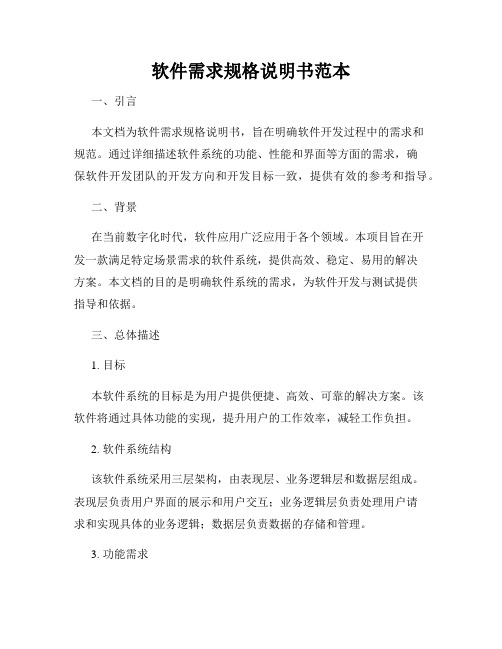
软件需求规格说明书范本一、引言本文档为软件需求规格说明书,旨在明确软件开发过程中的需求和规范。
通过详细描述软件系统的功能、性能和界面等方面的需求,确保软件开发团队的开发方向和开发目标一致,提供有效的参考和指导。
二、背景在当前数字化时代,软件应用广泛应用于各个领域。
本项目旨在开发一款满足特定场景需求的软件系统,提供高效、稳定、易用的解决方案。
本文档的目的是明确软件系统的需求,为软件开发与测试提供指导和依据。
三、总体描述1. 目标本软件系统的目标是为用户提供便捷、高效、可靠的解决方案。
该软件将通过具体功能的实现,提升用户的工作效率,减轻工作负担。
2. 软件系统结构该软件系统采用三层架构,由表现层、业务逻辑层和数据层组成。
表现层负责用户界面的展示和用户交互;业务逻辑层负责处理用户请求和实现具体的业务逻辑;数据层负责数据的存储和管理。
3. 功能需求本软件系统的功能需求如下:- 用户注册与登录- 信息录入和查询- 业务处理和操作- 数据分析和报表生成4. 性能需求为保证软件系统的性能,需满足以下需求:- 响应速度快:用户操作后系统应迅速响应,无明显的卡顿现象。
- 高并发支持:系统应对大量用户同时访问具备较好的处理能力。
- 数据存储安全:系统应保证数据的完整性和安全性,避免数据丢失或被非法篡改。
五、详细需求描述1. 用户注册与登录本系统提供用户注册和登录功能,要求如下:- 用户注册:用户可以通过注册功能创建新的账号,需提供用户名、密码、手机号码等必要信息。
- 用户登录:已注册用户可以通过输入用户名和密码进行登录,系统应验证用户身份并进入主界面。
2. 信息录入和查询本系统提供信息录入和查询功能,要求如下:- 信息录入:用户可以通过界面输入信息,并保存至数据库中。
- 信息查询:用户可以通过指定条件查询数据库中的信息,并展示在界面上。
3. 业务处理和操作本系统提供业务处理和操作功能,要求如下:- 业务处理:系统应能根据用户输入的数据进行相应的业务处理,并将结果反馈给用户。
软件需求规格说明书

1XXX公司{项目名称}软件需求规格说明书编号:版本: V1.0发布日期: 2021-11-1文件修订记录目录1 概述 (1)1.1 目的 (1)1.2 术语及缩略语 (1)2 引用文档 (1)3 综合描述 (1)3.1 系统功能结构图 (1)3.2 系统功能列表 (1)3.3 系统角色说明 (2)4 系统功能 (3)4.1功能用例X(例如监控系统) (3)4.2 用例参与者描述(例如操作员) (3)4.3 流程图(例如操作流程) (3)4.4 用例描述(例如) (3)4.5 界面示例(例如) (4)4.5.1 子功能用例x(例如: ) (6)5 系统运行环境 (6)5.1 硬件环境 (6)5.2 软件环境 (6)5.3 网络环境 (6)5.4 通信环境 (6)6 性能需求 (6)6.1 系统容量估算 (6)6.2 性能指标 (6)7 接口需求 (7)7.1 硬件接口 (7)7.2 软件接口 (7)7.2.1 软件外部接口 (7)7.2.2 软件内部接口 (7)7.3 通信接口 (7)8 用户特殊需求 (8)8.1 安全性需求 (8)8.2 备份与恢复 (8)8.3 与旧系统衔接 (8)8.4 条件与限制 (9)8.5 数据移植 (9)8.6 数据维护 (9)8.7 标准需求 (9)8.8 不需要的特性 (9)9 质量属性 (9)2 概述2.1 目的描述编写本文档目的2.2 术语及缩略语表 2-1本文档使用的术语及缩略语一览表3 引用文档表 3-1引用文档一览表4 综合描述4.1 系统功能结构图图 4-1 系统功能结构图4.2 系统功能列表4.3系统角色说明表4-1 用户角色说明表5系统功能5.1功能用例X(例如监控系统)5.2用例参与者描述(例如操作员)5.3本系统除定义了外部的参与者, 还定义了“时间”的参与者, 主要用于描述系统中用例的交互。
5.4流程图(例如操作流程)5.5用例描述(例如)5.6界面示例(例如)子功能用例x(例如: )5.6.1.1用例参与者描述5.6.1.2流程图5.6.1.3用例描述5.6.1.4界面示例5.6.1.5业务规则/算法1.页面的功能操作, 做局部刷新, 不刷新整个页面;2.删除文件夹时, 文件夹及包含的所有文件都删除;3.共享的文件夹与不共享的文件夹在图片展示时需要区分;4.删除共享的文件夹或删除的文件夹内包含共享文件夹, 系统需要给出用户提示, 用户决定是否删除;如果删除的是所属于该共享文件夹内的文件夹或者文件, 不用做是否删除共享的提示;5.6.1.6上传的文件名前显示的格式图标, 系统内置;5.6.1.7数据需求表5-1 情报板数据字段名称类型宽度取值范来源缺省空备注6系统运行环境6.1硬件环境6.2软件环境表6-2 运行环境中软件项一览表6.3网络环境6.4通信环境7性能需求7.1系统容量估算7.2描述对系统容量需求的估算, 如数据库记录估算、数据库初始化需求、批处理作业估算、实时作业估算。
软件需求规格说明模版
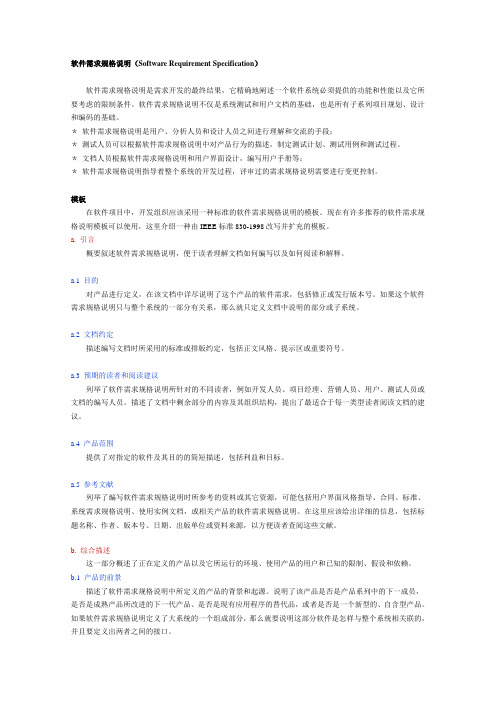
软件需求规格说明(Software Requirement Specification)软件需求规格说明是需求开发的最终结果,它精确地阐述一个软件系统必须提供的功能和性能以及它所要考虑的限制条件。
软件需求规格说明不仅是系统测试和用户文档的基础,也是所有子系列项目规划、设计和编码的基础。
*软件需求规格说明是用户、分析人员和设计人员之间进行理解和交流的手段;*测试人员可以根据软件需求规格说明中对产品行为的描述,制定测试计划、测试用例和测试过程。
*文档人员根据软件需求规格说明和用户界面设计,编写用户手册等;*软件需求规格说明指导着整个系统的开发过程,评审过的需求规格说明需要进行变更控制。
模板在软件项目中,开发组织应该采用一种标准的软件需求规格说明的模板。
现在有许多推荐的软件需求规格说明模板可以使用,这里介绍一种由IEEE标准830-1998改写并扩充的模板。
a. 引言概要叙述软件需求规格说明,便于读者理解文档如何编写以及如何阅读和解释。
a.1 目的对产品进行定义,在该文档中详尽说明了这个产品的软件需求,包括修正或发行版本号。
如果这个软件需求规格说明只与整个系统的一部分有关系,那么就只定义文档中说明的部分或子系统。
a.2 文档约定描述编写文档时所采用的标准或排版约定,包括正文风格、提示区或重要符号。
a.3 预期的读者和阅读建议列举了软件需求规格说明所针对的不同读者,例如开发人员、项目经理、营销人员、用户、测试人员或文档的编写人员。
描述了文档中剩余部分的内容及其组织结构,提出了最适合于每一类型读者阅读文档的建议。
a.4 产品范围提供了对指定的软件及其目的的简短描述,包括利益和目标。
a.5 参考文献列举了编写软件需求规格说明时所参考的资料或其它资源,可能包括用户界面风格指导、合同、标准、系统需求规格说明、使用实例文档,或相关产品的软件需求规格说明。
在这里应该给出详细的信息,包括标题名称、作者、版本号、日期、出版单位或资料来源,以方便读者查阅这些文献。
软件需求规格说明书范本IT软件行业

软件需求规格说明书范本IT软件行业软件需求规格说明书1. 引言本文档旨在详细说明IT软件行业中的软件需求规格,在开发和设计软件之前,确保所有相关人员对软件功能、性能和设计等方面的需求有准确的了解。
本文档将涵盖整个软件需求规格说明书的范本。
2. 背景在IT软件行业,开发软件需要明确的规范和需求。
软件需求规格说明书是确保软件开发项目成功的关键文件之一。
该文档描述了软件的功能、性能和设计需求,以及与软件实现和交付相关的所有重要信息。
3. 需求定义3.1 用户需求用户需求是软件需求规格说明书的基础。
这个部分将详细记录客户对软件功能和性能的要求,包括用户界面、功能模块、数据存储、安全性等方面的需求。
3.2 系统需求系统需求定义了软件运行的环境和软件实现的必要条件。
这个部分将包括软件平台要求、操作系统要求、硬件要求等相关信息。
4. 功能需求4.1 基本功能软件需求规格说明书应明确描述软件的基本功能。
这个部分将列举和描述软件所需的基本功能,包括但不限于页面导航、数据输入、数据输出等。
4.2 高级功能软件需求规格说明书还应包含对高级功能的详细描述。
这个部分将列出软件的高级功能要求,可能包括账户管理、数据分析、任务调度等。
5. 性能需求5.1 响应时间软件需求规格说明书应指定软件在不同场景下的响应时间要求。
这个部分将描述软件对用户操作的响应速度要求,如页面加载时间、数据处理速度等。
5.2 容量要求软件在处理大量数据时需要有足够的容量支持。
这个部分将说明软件对数据库或其他数据存储系统的容量要求。
6. 设计约束6.1 界面设计软件需求规格说明书还应包含对软件界面设计的约束和要求。
这个部分将包括界面布局、颜色方案、字体选择等相关内容。
6.2 安全要求软件需求规格说明书应指定软件对数据和用户隐私的安全要求。
这个部分将描述软件需要具备的加密、数据保护和用户身份验证等功能。
7. 数据要求7.1 数据输入软件需求规格说明书应清楚地说明软件对不同类型数据的输入要求。
软件需求规格说明书

一.引言[软件需求规格说明书记录对系统或系统的一部分的完整软件需求。
以下是一个典型的软件需求规格说明书概述,用于涉及用例建模的项目。
此工件由一个包组成,该包包含用例模型的用例、非功能性需求、接口需求以及其他支持信息。
本文档模板适合采用用例建模技术的项目需求描述。
]---- 在正式编写文档时,请删除内容要求部分。
1.1编写目的本文档作为***与XXXXXXXXXX公司之间就***建立XXXX司(局或单位)论坛系统需求理解达成一致共识的基础文件,作为双方界定项目范围、签定合同的主要基础,也作为本项目验收的主要依据。
同时,本文档也作为***后继工作开展的基础,供双方项目主管负责人、项目经理、技术开发人员、测试人员等理解需求之用。
1.2适用范围本文档适用于所有与本项目有关的软件开发阶段及其相关人员,其中:***方面的项目负责人、公司方项目经理、技术开发人员(包括分析人员、设计人员、程序人员)、测试人员应重点阅读本文档各部分,其他人员可选择性阅读本文档。
1.3文档概述本文档主要描述了论坛系统项目的软件需求。
本文档首先从业务背景、系统功能、运行环境等方面概要描述系统,其次从用户界面、软件接口等方面描述系统的外部接口需求,然后进一步详细描述功能性需求和非功能性需求以及待确定的问题。
1.4参考资料[列出本文的参考文件清单,包括出版单位、作者、版本、日期等信息。
]示范:―――仅供参考,不具备任何实质性的内容。
《XXX总体需求书》(XXX单位XXX提供)《XXX需求调研报告》作者:XXX《设计模式》XXXXX出版社1.5术语、定义和缩写[列出本文档所涉及的专业术语、缩写词及相关定义。
定义所有必要的术语,以便读者可以正确地解释软件需求规格说明,包括词头和缩写。
你可能希望为整个公司创建一张跨越多项项目的词汇表,并且只包括特定于单一项目的软件需求规格说明中的术语。
]示范:―――仅供参考,不具备任何实质性的内容。
1)OLTP:On-line Transaction Processing,联机事务处理。
软件行业软件需求规格说明书范本

软件行业软件需求规格说明书范本软件需求规格说明书一、引言本文档是为软件行业而编写的软件需求规格说明书范本。
本文档的目的是明确软件需求的功能、性能和约束等方面的要求,以帮助开发团队了解用户的需求并设计开发出相应的软件。
二、背景软件行业是一个快速发展的行业,软件需求的准确描述是确保软件开发成功的关键之一。
本文档所描述的软件需求规格将对软件行业的开发人员、测试人员和维护人员提供指导。
三、需求描述在本节中,将详细描述软件需求。
根据软件行业的特点和具体需求,以下是软件需求的几个方面。
1. 功能需求(1)主要功能:列出软件应具备的主要功能,包括但不限于用户管理、数据分析、任务跟踪等。
(2)辅助功能:列出软件的辅助功能,如数据导入、导出、权限管理等功能。
2. 性能需求(1)响应时间:规定软件对用户请求的响应时间,例如系统启动时间、页面加载时间等。
(2)吞吐量:规定软件每秒钟能处理的最大请求量。
(3)可用性:规定软件需要有多久的可用性,以确保系统在一段时间内能够正常运行。
3. 可靠性需求(1)稳定性:规定软件需要多久能够持续运行而不发生故障。
(2)备份与恢复:规定软件需要提供的备份与恢复功能。
4. 约束条件(1)硬件约束:指明软件需要在何种硬件环境下运行,如操作系统、处理器、内存等要求。
(2)软件约束:指明软件需要与其他已有软件的兼容性,并描述相应要求。
5. 用户界面(1)界面布局:指定软件的界面布局和组件排列方式。
(2)界面设计:提供软件的界面设计方式和相关要求。
四、开发计划本节将介绍软件开发和测试的计划,以确保软件按时交付和质量可靠。
1. 开发过程(1)需求分析:明确软件需求,并编写本文档。
(2)设计开发:根据需求分析进行软件设计和开发。
(3)测试:对软件进行测试,包括单元测试、集成测试和系统测试等。
(4)发布:将软件发布到客户端并进行用户培训。
2. 测试计划(1)测试目标:明确测试的目标和范围。
(2)测试方法和工具:描述使用的测试方法和测试工具。
软件需求规格说明书
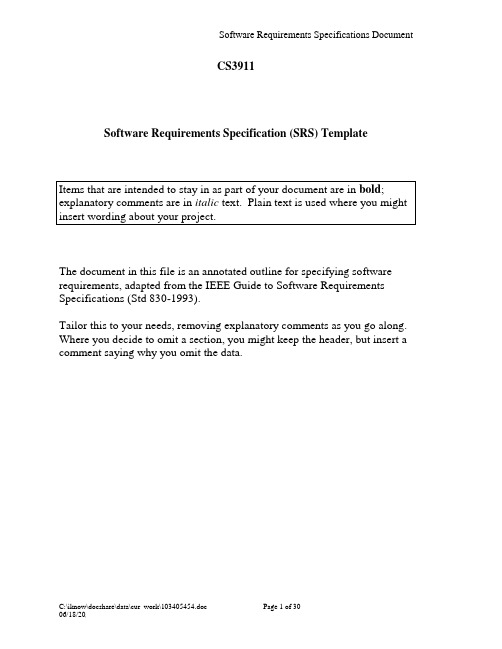
CS3911Software Requirements Specification (SRS) TemplateThe document in this file is an annotated outline for specifying software requirements, adapted from the IEEE Guide to Software Requirements Specifications (Std 830-1993).Tailor this to your needs, removing explanatory comments as you go along. Where you decide to omit a section, you might keep the header, but insert a comment saying why you omit the data.CS3911(Team Number)(Team Name)Software Requirements SpecificationDocumentVersion: (n)Date: (mm/dd/yyyy)Table of Contents1. Introduction 51.1 Purpose 51.2 Scope 51.3 Definitions, Acronyms, and Abbreviations 51.4 References 51.5 Overview6 2. The Overall Description 62.1 Product Perspective 62.1.1 System Interfaces 62.1.2 Interfaces 72.1.3 Hardware Interfaces 72.1.4 Software Interfaces 72.1.5 Communications Interfaces 82.1.6 Memory Constraints 82.1.7 Operations 82.1.8 Site Adaptation Requirements 92.2 Product Functions 92.3 User Characteristics 102.4 Constraints 102.5 Assumptions and Dependencies 102.6 Apportioning of Requirements10 3. Specific Requirements 113.1 External interfaces 123.2 Functions 123.3 Performance Requirements 133.4 Logical Database Requirements 143.5 Design Constraints 143.5.1 Standards Compliance 143.6 Software System Attributes 143.6.1 Reliability 153.6.2 Availability 153.6.3 Security 153.6.4 Maintainability 153.6.5 Portability 163.7 Organizing the Specific Requirements 173.7.1 System Mode 173.7.2 User Class 173.7.3 Objects 173.7.4 Feature 173.7.5 Stimulus 173.7.6 Response 183.7.7 Functional Hierarchy 183.8 Additional Comments18 4. Change Management Process5. Document Approvals6. Supporting Information 181. IntroductionThe following subsections of the Software Requirements Specifications (SRS) document should provide an overview of the entire SRS. The thing to keep in mind as you write this document is that you are telling what the system must do – so that designers can ultimately build it. Do not use this document for design!!!1.1 PurposeIdentify the purpose of this SRS and its intended audience. In this subsection, describe the purpose of the particular SRS and specify the intended audience for the SRS.1.2 ScopeIn this subsection:(1) Identify the software product(s) to be produced by name(2) Explain what the software product(s) will, and, if necessary, will not do(3) Describe the application of the software being specified, including relevantbenefits, objectives, and goals(4) Be consistent with similar statements in higher-level specifications if they existThis should be an executive-level summary. Do not enumerate the whole requirements list here.1.3 Definitions, Acronyms, and Abbreviations.Provide the definitions of all terms, acronyms, and abbreviations required to properly interpret the SRS. This information may be provided by reference to one or more appendices in the SRS or by reference to documents. This information may be provided by reference to an Appendix.1.4 ReferencesIn this subsection:(1) Provide a complete list of all documents referenced elsewhere in the SRS(2) Identify each document by title, report number (if applicable), date, andpublishing organization(3)Specify the sources from which the references can be obtained.This information can be provided by reference to an appendix or to another document. If your application uses specific protocols or RFC’s, then reference them here so designers know where to find them.1.5 OverviewIn this subsection:(1)Describe what the rest of the SRS contains(2)Explain how the SRS is organizedDon’t rehash the table of contents here. Point people to the parts of th e document they are most concerned with. Customers/potential users care about section 2, developers care about section 3.2. The Overall DescriptionDescribe the general factors that affect the product and its requirements. This section does not state specific requirements. Instead, it provides a background for those requirements, which are defined in section 3, and makes them easier to understand. In a sense, this section tells the requirements in plain English for the consumption of the customer. Section3 will contain a specification written for the developers.2.1 Product PerspectivePut the product into perspective with other related products. If the product is independent and totally self-contained, it should be so stated here. If the SRS defines a product that is a component of a larger system, as frequently occurs, then this subsection relates the requirements of the larger system to functionality of the software and identifies interfaces between that system and the software. If you are building a real system,compare its similarity and differences to other systems in the marketplace. If you are doing a research-oriented project, what related research compares to the system you are planning to build.A block diagram showing the major components of the larger system, interconnections, and external interfaces can be helpful. This is not a design or architecture picture. It is more to provide context, especially if your system will interact with external actors. The system you are building should be shown as a black box. Let the design document present the internals.The following subsections describe how the software operates inside various constraints.2.1.1 System InterfacesList each system interface and identify the functionality of the software to accomplish the system requirement and the interface description to match the system. These are external systems that you have to interact with. For instance, if you are building a business application that interfaces with the existing employee payroll system, what is the API to that system that designer’s will need to use?2.1.2 InterfacesSpecify:(1)The logical characteristics of each interface between the software product and itsusers.(2)All the aspects of optimizing the interface with the person who must use the system This is a description of how the system will interact with its users. Is there a GUI, a command line or some other type of interface? Are there special interface requirements? If you are designing for the general student population for instance, what is the impact of ADA (American with Disabilities Act) on your interface?2.1.3 Hardware InterfacesSpecify the logical characteristics of each interface between the software product and the hardware components of the system. This includes configuration characteristics. It also covers such matters as what devices are to be supported, how they are to be supported and protocols. This is not a description of hardware requirements in the sense that “This program must ru n on a Mac with 64M of RAM”. This section is for detailing the actual hardware devices your application will interact with and control. For instance, if you are controlling X10 type home devices, what is the interface to those devices? Designers should be able to look at this and know what hardware they need to worry about in the design. Many business type applications will have no hardware interfaces. If none, just state “The system has no hardware interface requirements” If you just delete sections that are not applicable, then readers do not know if: a. this does not apply or b. you forgot to include the section in the first place.2.1.4 Software InterfacesSpecify the use of other required software products and interfaces with other application systems. For each required software product, include:(1)Name(2)Mnemonic(3)Specification number(4)Version number(5)SourceFor each interface, provide:(1)Discussion of the purpose of the interfacing software as related to this softwareproduct(2)Definition of the interface in terms of message content and formatHere we document the APIs, versions of software that we do not have to write, but that our system has to use. For instance if your customer uses SQL Server 7 and you are required to use that, then you need to specify i.e.2.1.4.1 Microsoft SQL Server 7. The system must use SQL Server as its database component. Communication with the DB is through ODBC connections. The system must provide SQL data table definintions to be provided to the company DBA for setup.A key point to remember is that you do NOT want to specify software here that you think would be good to use. This is only for customer-specified systems that you have to interact with. Choosing SQL Server 7 as a DB without a customer requirement is a Design choice, not a requirement. This is a subtle but important point to writing good requirements and not over-constraining the design.2.1.5 Communications InterfacesSpecify the various interfaces to communications such as local network protocols, etc. These are protocols you will need to directly interact with. If you happen to use web services transparently to your application then do not list it here. If you are using a custom protocol to communicate between systems, then document that protocol here so designers know what to design. If it is a standard protocol, you can reference an existing document or RFC.2.1.6 Memory ConstraintsSpecify any applicable characteristics and limits on primary and secondary memory. Don’t just make up something here. If all the customer’s machines have only 128K of RAM, then your target design has got to come in under 128K so there is an actual requirement. You could also cite market research here for shrink-wrap type applications “Focus groups have determin ed that our target market has between 256-512M of RAM, therefore the design footprint should not exceed 256M.” If there are no memory constraints, so state.2.1.7 OperationsSpecify the normal and special operations required by the user such as:(1)The various modes of operations in the user organization(2)Periods of interactive operations and periods of unattended operations(3)Data processing support functions(4)Backup and recovery operations(Note: This is sometimes specified as part of the User Interfaces section.) If you separate this from the UI stuff earlier, then cover business process type stuff that would impact the design. For instance, if the company brings all their systems down at midnight for data backup that might impact the design. These are all the work tasks that impact the design of an application, but which might not be located in software.2.1.8 Site Adaptation RequirementsIn this section:(1)Define the requirements for any data or initialization sequences that are specificto a given site, mission, or operational mode(2)Specify the site or mission-related features that should be modified to adapt thesoftware to a particular installationIf any modifications to the customer’s work area would be required by your system, then document that here. For instance, “A 100Kw backup generator and 10000 BTU air conditioning system must be installed at the user site prior to software installation”. This could also be software-specific like, “New data tables created for this system must be installed o n the company’s existing DB server and populated prior to system activation.” Any equipment the customer would need to buy or any software setup that needs to be done so that your system will install and operate correctly should be documented here.2.2 Product FunctionsProvide a summary of the major functions that the software will perform. Sometimes the function summary that is necessary for this part can be taken directly from the section of the higher-level specification (if one exists) that allocates particular functions to the software product.For clarity:(1)The functions should be organized in a way that makes the list of functionsunderstandable to the customer or to anyone else reading the document for the first time.(2)Textual or graphic methods can be used to show the different functions and theirrelationships. Such a diagram is not intended to show a design of a product but simply shows the logical relationships among variables.AH, Finally the real meat of section 2. This describes the functionality of the system in the language of the customer. What specifically does the system that will be designed have to do? Drawings are good, but remember this is a description of what the system needs to do, not how you are going to build it. (That comes in the design document).2.3 User CharacteristicsDescribe those general characteristics of the intended users of the product including educational level, experience, and technical expertise. Do not state specific requirements but rather provide the reasons why certain specific requirements are later specified in section 3.What is it about your potential user base that will impact the design? Their experience and comfort with technology will drive UI design. Other characteristics might actually influence internal design of the system.2.4 ConstraintsProvide a general description of any other items that will limit the developer's options. These can include:(1) Regulatory policies(2) Hardware limitations (for example, signal timing requirements)(3) Interface to other applications(4) Parallel operation(5) Audit functions(6) Control functions(7) Higher-order language requirements(8) S ignal handshake protocols (for example, XON-XOFF, ACK-NACK)(9) R eliability requirements(10) Criticality of the application(11) Safety and security considerationsThis section captures non-functional requirements in the customers language. A more formal presentation of these will occur in section 3.2.5 Assumptions and DependenciesList each of the factors that affect the requirements stated in the SRS. These factors are not design constraints on the software but are, rather, any changes to them that can affect the requirements in the SRS. For example, an assumption might be that a specific operating system would be available on the hardware designated for the software product. If, in fact, the operating system were not available, the SRS would then have to change accordingly.This section is catch-all for everything else that might influence the design of the system and that did not fit in any of the categories above.2.6 Apportioning of Requirements.Identify requirements that may be delayed until future versions of the system. After you look at the project plan and hours available, you may realize that you just cannot get everything done. This section divides the requirements into different sections for development and delivery. Remember to check with the customer – they should prioritize the requirements and decide what does and does not get done. This can also be useful if you are using an iterative life cycle model to specify which requirements will map to which interation.3. Specific RequirementsThis section contains all the software requirements at a level of detail sufficient to enable designers to design a system to satisfy those requirements, and testers to test that the system satisfies those requirements. Throughout this section, every stated requirement should be externally perceivable by users, operators, or other external systems. These requirements should include at a minimum a description of every input (stimulus) into the system, every output (response) from the system and all functions performed by the system in response to an input or in support of an output. The following principles apply:(1)Specific requirements should be stated with all the characteristics of a good SRS∙correct∙unambiguous∙complete∙consistent∙ranked for importance and/or stability∙verifiable∙modifiable∙traceable(2)Specific requirements should be cross-referenced to earlier documents that relate(3)All requirements should be uniquely identifiable (usually via numbering like3.1.2.3)(4)Careful attention should be given to organizing the requirements to maximizereadability (Several alternative organizations are given at end of document)Before examining specific ways of organizing the requirements it is helpful to understand the various items that comprise requirements as described in the following subclasses. This section reiterates section 2, but is for developers not the customer. The customer buys in with section 2, the designers use section 3 to design and build the actual application.Remember this is not design. Do not require specific software packages, etc unless the customer specifically requires them. Avoid over-constraining your design. Use proper terminology:The system shall… A required, must have featureThe system should… A desired feature, but may be deferred til laterThe system may… An optional, nice-to-have feature that may never make it to implementation.Each requirement should be uniquely identified for traceability. Usually, they are numbered 3.1, 3.1.1, 3.1.2.1 etc. Each requirement should also be testable. Avoid imprecise statements like, “The system shall be easy to use” Well no kidding, what does that mean? Avoid “motherhood and apple pie” type statements, “The system shall be developed using good software engineering practice”Avoid examples, This is a specification, a designer should be able to read this spec and build the system without bothering the customer again. Don’t say things like, “The system shall accept configuration information such as name and address.” The designer doesn’t know if that is the only two data elements or if there are 200. List every piece of information that is required so the designers can build the right UI and data tables.3.1 External InterfacesThis contains a detailed description of all inputs into and outputs from the software system. It complements the interface descriptions in section 2 but does not repeat information there. Remember section 2 presents information oriented to thecustomer/user while section 3 is oriented to the developer.It contains both content and format as follows:∙Name of item∙Description of purpose∙Source of input or destination of output∙Valid range, accuracy and/or tolerance∙Units of measure∙Timing∙Relationships to other inputs/outputs∙Screen formats/organization∙Window formats/organization∙Data formats∙Command formats∙End messages3.2 FunctionsFunctional requirements define the fundamental actions that must take place in the software in accepting and processing the inputs and in processing and generating the outputs. These are generally listed as “shall” statements starting with "The systemsha ll…These include:∙Validity checks on the inputs∙Exact sequence of operations∙Responses to abnormal situation, including∙Overflow∙Communication facilities∙Error handling and recovery∙Effect of parameters∙Relationship of outputs to inputs, including∙Input/Output sequences∙Formulas for input to output conversionIt may be appropriate to partition the functional requirements into sub-functions or sub-processes. This does not imply that the software design will also be partitioned that way.3.3 Performance RequirementsThis subsection specifies both the static and the dynamic numerical requirements placed on the software or on human interaction with the software, as a whole. Static numerical requirements may include:(a) The number of terminals to be supported(b) The number of simultaneous users to be supported(c) Amount and type of information to be handledStatic numerical requirements are sometimes identified under a separate section entitled capacity.Dynamic numerical requirements may include, for example, the numbers of transactions and tasks and the amount of data to be processed within certain time periods for both normal and peak workload conditions.All of these requirements should be stated in measurable terms.For example,95% of the transactions shall be processed in less than 1 secondrather than,An operator shall not have to wait for the transaction to complete.(Note: Numerical limits applied to one specific function are normally specified as part of the processing subparagraph description of that function.)3.4 Logical Database RequirementsThis section specifies the logical requirements for any information that is to be placed into a database. This may include:∙Types of information used by various functions∙Frequency of use∙Accessing capabilities∙Data entities and their relationships∙Integrity constraints∙Data retention requirementsIf the customer provided you with data models, those can be presented here. ER diagrams (or static class diagrams) can be useful here to show complex data relationships. Remember a diagram is worth a thousand words of confusing text.3.5 Design ConstraintsSpecify design constraints that can be imposed by other standards, hardware limitations, etc.3.5.1 Standards ComplianceSpecify the requirements derived from existing standards or regulations. They might include:(1) Report format(2) Data naming(3) Accounting procedures(4) Audit TracingFor example, this could specify the requirement for software to trace processing activity. Such traces are needed for some applications to meet minimum regulatory or financial standards. An audit trace requirement may, for example, state that all changes to a payroll database must be recorded in a trace file with before and after values.3.6 Software System AttributesThere are a number of attributes of software that can serve as requirements. It is important that required attributes by specified so that their achievement can be objectively verified. The following items provide a partial list of examples. These are also known as non-functional requirements or quality attributes.These are characteristics the system must possess, but that pervade (or cross-cut) the design. These requirements have to be testable just like the functional requirements. Its easy to start philosophizing here, but keep it specific.3.6.1 ReliabilitySpecify the factors required to establish the required reliability of the software system at time of delivery. If you have MTBF requirements, express th em here. This doesn’t refer to just having a program that does not crash. This has a specific engineering meaning.3.6.2 AvailabilitySpecify the factors required to guarantee a defined availability level for the entire system such as checkpoint, recovery, and restart. This is somewhat related to reliability. Some systems run only infrequently on-demand (like MS Word). Some systems have to run 24/7 (like an e-commerce web site). The required availability will greatly impact the design. What are th e requirements for system recovery from a failure? “The system shall allow users to restart the application after failure with the loss of at most 12 characters of input”.3.6.3 SecuritySpecify the factors that would protect the software from accidental or malicious access, use, modification, destruction, or disclosure. Specific requirements in this area could include the need to:∙Utilize certain cryptographic techniques∙Keep specific log or history data sets∙Assign certain functions to different modules∙Restrict communications between some areas of the program∙Check data integrity for critical variables3.6.4 MaintainabilitySpecify attributes of software that relate to the ease of maintenance of the software itself. There may be some requirement for certain modularity, interfaces, complexity, etc. Requirements should not be placed here just because they are thought to be good design practices. If someone else will maintain the system3.6.5 PortabilitySpecify attributes of software that relate to the ease of porting the software to other host machines and/or operating systems. This may include:∙Percentage of components with host-dependent code∙Percentage of code that is host dependent∙Use of a proven portable language∙Use of a particular compiler or language subset∙Use of a particular operating systemOnce the relevant characteristics are selected, a subsection should be written for each, explaining the rationale for including this characteristic and how it will be tested and measured. A chart like this might be used to identify the key characteristics (rating them High or Medium), then identifying which are preferred when trading off design or implementation decisions (with the ID of the preferred one indicated in the chart to the right). The chart below is optional (it can be confusing) and is for demonstrating tradeoff analysis between different non-functional requirements. H/M/L is the relative priority of that non-functional requirement.Definitions of the quality characteristics not defined in the paragraphs above follow.•Correctness - extent to which program satisfies specificat ions, fulfills user’s mission objectives•Efficiency - amount of computing resources and code required to perform function •Flexibility - effort needed to modify operational program•Interoperability - effort needed to couple one system with another•Reliability - extent to which program performs with required precision•Reusability - extent to which it can be reused in another application•Testability - effort needed to test to ensure performs as intended•Usability - effort required to learn, operate, prepare input, and interpret output THE FOLLOWING (3.7) is not really a section, it is talking about how to organize requirements you write in section 3.2. At the end of this template there are a bunch of alternative organizations for section 3.2. Choose the ONE best for the system you are writing the requirements for.3.7 Organizing the Specific RequirementsFor anything but trivial systems the detailed requirements tend to be extensive. For this reason, it is recommended that careful consideration be given to organizing these in a manner optimal for understanding. There is no one optimal organization for all systems. Different classes of systems lend themselves to different organizations of requirements in section 3. Some of these organizations are described in the following subclasses.3.7.1 System ModeSome systems behave quite differently depending on the mode of operation. When organizing by mode there are two possible outlines. The choice depends on whether interfaces and performance are dependent on mode.3.7.2 User ClassSome systems provide different sets of functions to different classes of users.3.7.3 ObjectsObjects are real-world entities that have a counterpart within the system. Associated with each object is a set of attributes and functions. These functions are also called services, methods, or processes. Note that sets of objects may share attributes and services. These are grouped together as classes.3.7.4 FeatureA feature is an externally desired service by the system that may require a sequence of inputs to effect the desired result. Each feature is generally described in as sequence eof stimulus-response pairs.3.7.5 StimulusSome systems can be best organized by describing their functions in terms of stimuli.3. 7.6 ResponseSome systems can be best organized by describing their functions in support of the generation of a response.3.7.7 Functional HierarchyWhen none of he above organizational schemes prove helpful, the overall functionality can be organized into a hierarchy of functions organized by either common inputs, common outputs, or common internal data access. Data flow diagrams and data dictionaries can be use dot show the relationships between and among the functions and data.3.8 Additional CommentsWhenever a new SRS is contemplated, more than one of the organizational techniques given in 3.7 may be appropriate. In such cases, organize the specific requirements for multiple hierarchies tailored to the specific needs of the system under specification. Three are many notations, methods, and automated support tools available to aid in the documentation of requirements. For the most part, their usefulness is a function of organization. For example, when organizing by mode, finite state machines or state charts may prove helpful; when organizing by object, object-oriented analysis may prove helpful; when organizing by feature, stimulus-response sequences may prove helpful; when organizing by functional hierarchy, data flow diagrams and data dictionaries may prove helpful.In any of the outlines below, those sections called “Functional Requirement i” may be described in native language, in pseudocode, in a system definition language, or in four subsections titled: Introduction, Inputs, Processing, Outputs.4.Change Management ProcessIdentify the change management process to be used to identify, log, evaluate, and update the SRS to reflect changes in project scope and requirements. How are you going to control changes to the requirements. Can the customer just call up and ask for something new? Does your team have to reach consensus? How do changes to requirements get submitted to the team? Formally in writing, email or phone call? 5.Document Approvals。
- 1、下载文档前请自行甄别文档内容的完整性,平台不提供额外的编辑、内容补充、找答案等附加服务。
- 2、"仅部分预览"的文档,不可在线预览部分如存在完整性等问题,可反馈申请退款(可完整预览的文档不适用该条件!)。
- 3、如文档侵犯您的权益,请联系客服反馈,我们会尽快为您处理(人工客服工作时间:9:00-18:30)。
XXX系统
软件需求规格说明书
文件状态:[√] 草稿[ ] 正式发布[ ] 正在修改
文件标识:Team
当前版本:V1.0
作者:Maxwell C. Dong
完成日期:2011-02-14 拓胜(广州)计算机技术服务有限公司TOcean Training &. Consultation Inc.
2011~2012
版本编号说明:如形成文件、变更内容和变更范围变更日期变更人批准日期批准人
目录
XXX系统 (1)
软件需求规格说明书 (1)
目录 (3)
1.软件产品描述 (4)
1.文档编写目的 (4)
2.产品名称 (4)
3.产品背景 (4)
4.名词解释 (4)
2.产品需求概述 (5)
1.功能简介 (5)
2.运行环境 (5)
3.条件与限制(可选) (5)
3.功能用例描述 (6)
1.产品参与者 (6)
2.功能需求 (6)
3.功能需求列表 (6)
4.详细功能需求 (7)
1.功能1 (7)
5.非功能性需求 (8)
1.性能 (8)
2.安全 (8)
3.备份与恢复 (8)
4.移植 (8)
5.健壮性 (8)
6.重用 (8)
7.维护 (8)
8.软件质量需求 (8)
6.附录 (9)
1.附录一——术语表 (9)
2.附录二——参考引用 (9)
1.软件产品描述
1.文档编写目的
【说明编写本软件需求规格说明书的目的,指出预期的读者。
】
2.产品名称
【本项目的名称,包括项目的全名、简称、代号、版本号。
】
3.产品背景
【本项目的背景,包括项目产品委托单位、开发单位和主管部门、该产品系统和其他系统的关系】4.名词解释
【参见附录一(术语表)。
】
2.产品需求概述
1.功能简介
【对产品的基本功能做一个简介,包括:
1.本产品的开发意图、应用目标及作用范围。
2.概略介绍了产品所具有的主要功能。
可以用列表的方法给出,也可以用图形表示主要的需求分组以及它们之间的联系,例如数据流程图的顶层图或类图等。
3.说明本产品与其他相关产品的关系,是独立产品还是一个较大产品的组成部分。
可以用表示外部接口和数据流的系统高层次图,或者方框图说明。
】
2.运行环境
1.硬件环境:
【详细列出本软件运行时所必须的最低硬件配置、推荐硬件配置(如主机、显示器、外部设备等)以及其它特殊设备。
】
2.软件环境:
【如操作系统、网络软件、数据库系统以及其它特殊软件要求。
】
3.条件与限制(可选)
【说明本软件在实现时所必须满足的条件和所受的限制,并给出相应的原因。
必须满足的条件包括输入数据的范围以及格式。
所受的限制包括软件环境、硬件环境等方面的内容。
例如:必须使用或者避免的特定技术、工具、编程语言和数据库;企业策略、政府法规或工业标准;硬件限制,例如定时需求或存储器限制;经费限制、开发期限;项目对外部因素存在的依赖。
例如其它项目开发的组件。
等等】
3.功能用例描述
1.产品参与者
【识别出产品系统的各类参与者,有必要时需要识别参与者之间的关系】
2.功能需求
【识别出产品系统的不同参与者的功能用例,使用用例图来描述】
3.功能需求列表
【用表格的方式列出所有的功能用例,并划分模块,对功能用例进行编号、命名】产品系统模块功能/用例编号功能/用例名称功能、用例简单描述
4.详细功能需求
1.功能1
功能点名称功能点编号
功能点[Describes the major functionality of the feature]
触发条件[List the events that trigger this function/feature]
输入[List the input data to this function / feature. ]
过程流描述/ 工作流描述[Describe all steps / process flow of the function/features in a logical sequence]编号# 流程描述
RF1/P1
RF1/P2
校验[Describe the validations required in the function / feature]
编号# 验证描述
输出[List the names of all reports that are generated from this function/feature]
特殊需求特征[State any special features required in this function/ feature]
处理能力[Mention the volume of transaction that need to be handled by this function/feature]
其他[Mention any other details or information that are not covered in this form]
2.用例活动图(可选)
【若用例需求比较复杂,则需要使用活动图来辅助上面的详细功能描述。
】
3.需求界面(可选)
【提供原型界面】
5.非功能性需求
1.性能
【阐述了不同的应用领域对产品性能的需求,并解释它们的原理以帮助开发人员作出合理的设计选择。
这些性能需求例如:
1、数据精确度:根据实际情况,确定软件最终输出数据(包括传输中)的数据精确度。
2、时间特性:说明开发的软件在响应时间、更新处理时间、数据转换与传输时间、运行时间等方
面所需达到的时间特性。
3、相互合作的用户数或者所支持的操作;
4、容量需求,例如存储器和磁盘容量的需求或者存储在数据库中表的最大行数
等等】
2.安全
【系统在认证、授权、访问控制以及审计等方面的要求】
3.备份与恢复
【系统数据的备份需求,例如:备份的频率、时间、地点等】
4.移植
【系统可移植性需求,包括:在不同的操作系统平台、应用服务器平台、数据库管理系统之间的迁移等】
5.健壮性
【系统的健壮性】
6.重用
【对产品提出可重用性要求,在不同的环境、行业、项目等实现重用。
】
7.维护
【对产品提出易维护的需求,例如:维护的时间段、人员配置、响应速度。
】
8.软件质量需求
【对软件开发过程的要求,如何保证软件的质量】
6.附录
1.附录一——术语表
【对重要的或是具有特殊意义的名词术语(包括词头和缩写)进行定义,以便读者可以正确地解释软件需求说明。
】
2.附录二——参考引用
【列出参考的文献、文档、规范等;注明材料的作者、标题、编号、发表日期、出版单位等】。
